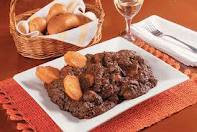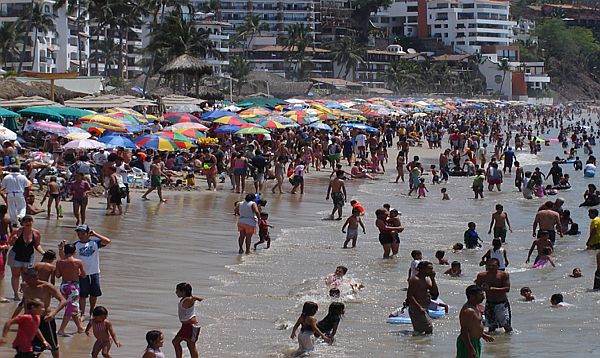Puerto Vallarta, Mexico - You've gotta love Mexico for how their people celebrate every possible holiday to the fullest. Every occasion is an excuse to eat, drink, decorate the town, and dance; and Semana Santa is the biggest fiesta of them all
In the United States and Canada we just celebrate Easter, and perhaps go to church on Good Friday. In Mexico, the festivities are two weeks long!
Since nearly 90% of Mexicans are Catholic, the weeks surrounding Easter are the most important time of celebration of the entire year. It is a time of release from the sacrifices of Lent.
As with each Mexican holiday season, certain food specialties began to appear in local markets just before its onset. For the Lenten period, you'll typically find very large dried shrimp for caldos (broths) and tortitas (croquettes), perfect heads of cauliflower for tortitas de coliflor (cauliflower croquettes), and seasonal romeritos (sprigs of a wild plant that looks like rosemary and is used to make many traditional lent dishes.)
Also common fare for this time of celebration are Pambazo which are special sandwiches drenched in a salsa, capirotada (bread pudding) and aguas frescas(fruit drinks.)
All of Mexico celebrates Semana Santa, and most cities will have reenactments of the events leading up to Christ's crucifixion on the cross. Torch lit processions, some silent (known as Processiσn del Silencio,) parade through city streets. They are colorful and amazing, fully-staged with costumes and performed; with participants preparing for their roles well before Lent even begins.
The most moving event of Semana Santa is the reenactment of the Passion of Christ, or the Passion Play. The events are sponsored by religious or community groups, and can include large processions of penitents, sometimes on their knees, a portrayal of the last supper and the crucifixion itself.
It is truly a beautiful time of year to be in Mexico, important religious images are displayed, altars are decorated at home and in the streets, and flower decorations and palm crosses are everywhere.
For the gringos and other foreigners who would like to try your hand at preparing a traditional Mexican dish for the Easter holiday, here is a recipe for the most popular of these.
Romeritos - A Sacred Mexican Dish
Romeritos are succulent, stringy-looking Mexican greens (Suaeda torreyana) that resemble rosemary and taste like spinach (which may be substituted.) They are traditionally served at Christmas time and Lent.
 |
| Romeritos - traditional 'Semana Santa' Mexican cuisine |
Ingredients:
3 pounds of romeritos or spinach
3 oz each of peanuts, almonds, nuts, and sesame seeds
1/2 onion
3 cloves garlic
1 roll of French bread toasted
1 tortilla toasted
1/2 cup raisins
1 bar Abuelita chocolate
3 chile ancho
3 chile pasilla
2 chile mulato
10 nopalitas (cactus)
2 pounds small potatoes cooked
chicken stock
1 1/4 cup dried shrimp
Directions
1. Clean and wash the romeritos (or spinach) with plenty of water to remove the soil from them and boil them in water. When the water gets dirty, change it and keep boiling until the romeritos are very soft, it takes at least 30 minutes. Take them out of the water and let them drip.
2. Shell the shrimp and grind them until they are a fine powder.
3. Wash the chilis and take the veins out, they are what makes them spicy.
4. Boil the chilis with half an onion and a peeled head of garlic. When the chili changes color and gets soft you can turn the fire off.
5. Boil the almonds so you can peel them - otherwise the mole tastes bitter.
6. Separately, toast the peanuts, the almonds, the nuts, and the raisins as each of them have their own toasting time. Turn the fire down, mix them together, and add the sesame seeds. The sesame seeds jump, so be careful to not get burned.
7. Boil the nopalita strips in water with salt. Only a moment, when they look yellowish and soft, take them out, rinse, and let them drain.
8. Put the ingredients you toasted already in a blender or food processors and mix. Be careful not to over-fill.
9. Blend the chili with the chicken stock and add the nuts, the toasted tortilla, the toasted bread and the powdered shrimp.
10. Put the ingredients of the blender or food processor into a pan and heat slowly. Stir constantly and carefully. Do not place your face close to smell it as the mole jumps. Mole does not mix with water it must mix with chicken stock, or it will pop when you are preparing it.
11. Add a spoon of bouillon of chicken powder. When the mole is cooked, add the chocolate Ibarra/Abuelita and taste it as you mix it, to sweeten it to your taste.
12. Add the nopalitas to the mole when this is boiling. Add the cooked romeritos and stir and stir and stir the mole. Taste it as you stir to adjust the salt, but you should not need more than two spoonfuls of it.
13. When it is almost ready, add the small potatoes, and cook for about 15 more minutes. Turn the fire off and let the Mole settle. You will have enough mole to freeze for later, just use the mole you need for the amount of romeritos you cook.
Enjoy.


